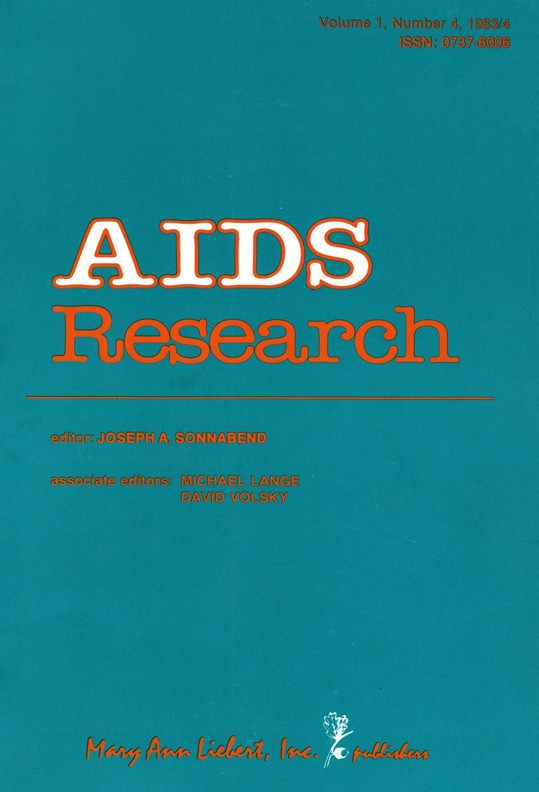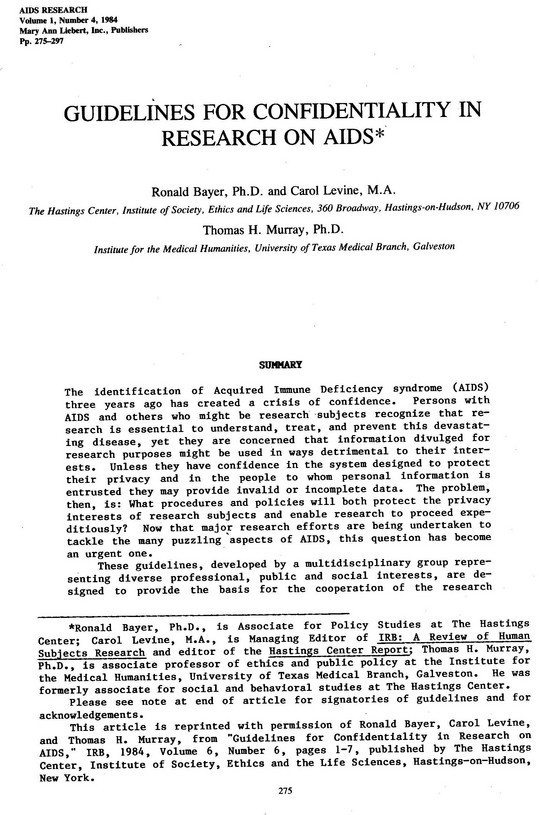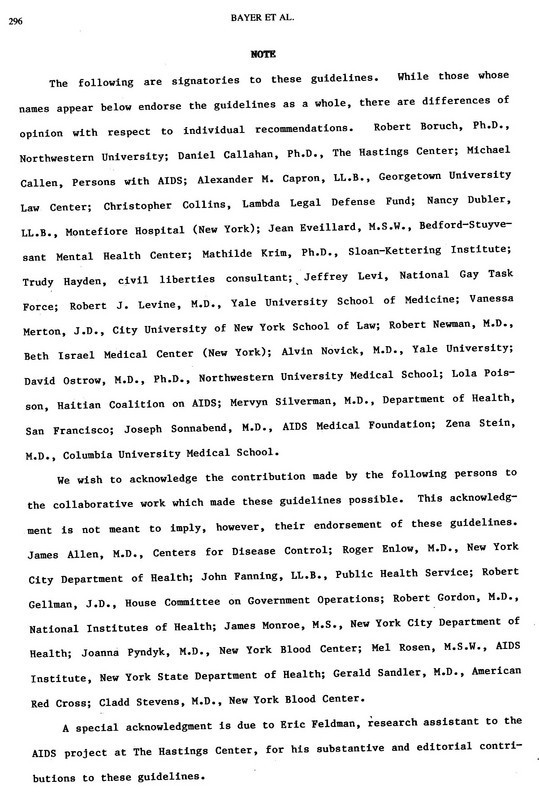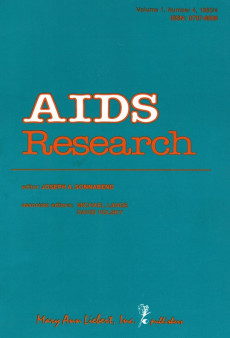Thirty years have passed since the epidemic began. For about half of this period we have had the means to effectively treat this disease. In N America and Europe where many HIV infected people were fortunate enough to have access to treatments almost as soon as they became available, most will have had no direct experience of the bewildering and awful early years of the epidemic.
During these first years affected individuals learned that they had to not only deal with the disease itself, but also with threats and attempts to deprive them of their rights. The right to privacy is one of these.
This post is about the very early recognition of the need to protect the confidentiality of people with AIDS. I will also write about some extraordinary people I have had the good fortune to have worked with and the person I will write about here is Jim Monroe. He probably was the first, at least in New York City, to do something about protecting the confidentiality of people with AIDS.
His concern led to the first formulation of guidelines for confidentiality protection in AIDS, and I’ll describe how this came about.
Jim worked for the Centers for Disease Control (CDC). He worked to improve the health of all, but it is people with AIDS who probably derived the greatest benefit from his efforts.
Those who do the most to help others often remain completely unnoticed. Maybe their commitment leaves no room for seeking personal attention; maybe they don’t care about recognition, or actively shun it.
Jim most certainly did not care about personal recognition. Apart from a few friends and colleagues and those who directly benefitted from his efforts, he remains largely unknown.
As physicians we protect the confidentiality of individuals who seek our care and who participate in research studies. As patients we have every right to expect this protection, and there are legal safeguards to ensure this. The CDC has extensively considered the issue of confidentiality protection in relation to AIDS and continues to do so.
However there was an earlier community response to confidentiality concerns in New York City in 1982 which started with a telephone call from Jim. This was at a time before HIV had been isolated and even before the disease was called AIDS.
I first met Jim in the late 1970s. At that time I was working for the New York City Health Department, concerned with sexually transmitted infections. Jim worked in the same field, but for the CDC. He was based in New York City. Our places of work were in close proximity and we met through our common interest in the control of sexually transmitted infections.
Confidentiality in matters of health is of the greatest importance, it can also be quite complex when transmissible infections are involved. We cannot avoid considering both the interests of the individual and the need to protect public health.
We have an obvious obligation to respect the trust placed in us by those who seek our care. But there are different and strongly held views on how to deal with the tensions that can exist between individual rights to privacy and a need to protect sexual partners, as well as society at large.
But the context in which Jim brought attention to confidentiality was the concern to protect individuals suffering from this new, untreatable, and as yet unnamed disease who were asked to participate in research studies.
From the very start, even before the discovery of HIV, affected individuals frequently had to contend not only with this frightening illness but with irrational and cruel discriminatory acts against them.
Even though the cause of AIDS was then unknown, it soon became clear that the illness could not be transmitted by casual contact. Despite this, discriminatory practices against people with AIDS were unfortunately all too common Some hospital patients had to retrieve meals left outside the doors to their rooms, some medical personnel refused to care for infected people, some children were not allowed to be in contact with people with AIDS, and affected children sometimes not even allowed to attend school.
With such irrational responses the need to protect the privacy of affected individuals is quite obvious.
Despite advances, AIDS is still a disease associated with stigmatization, not only in developing countries but also in the US and other developed nations. Protection of the privacy of HIV infected people is as important today as it was in the earliest years.
To properly describe how Jim started a response intended to assure that those affected by this new disease would be protected by measures to maintain their confidentiality, a few further introductory words are needed.
I started my own research into this new disease in 1981, and received tremendous support from an old colleague in the interferon field, Dr Mathilde Krim.
In 1983, my lawyer, Frank Hoffey, along with Graham Berry prepared the papers and incorporated the AIDS Medical Foundation (AMF), initially to raise funds to support my and my colleagues’ research. Apart from Mathilde’s personal support our work had not been funded. Quite correctly, AMF soon broadened its mission to support the work of others as well. The foundation survived and went on to make very significant contributions to the fight against AIDS, largely due to the determined efforts of Dr Krim who was the chairman of our board.
Concern with confidentiality started with an anxious call from Jim in 1982. The reason for his extreme agitation was that he knew that a study was to be undertaken on this new disease in the Health Department clinics for sexually transmitted infections. In particular, the clinic on 28th street was known to be the site where large numbers gay men were treated for sexually transmitted infections. The study would enrol with people who had “reversed T cell subset ratios”. A reversal of the normal CD4: CD8 ratio was how we recognized the disease before the designation AIDS was coined.
What concerned Jim was that no provision had been made to protect the confidentiality of study participants.
Jim told me that the study was to be submitted for review by the health department’s Institutional Review Board (IRB) although I don’t think it was called an IRB.
I suppose he must have had little confidence that the IRB, which is a body regulated by the FDA and intended to protect human research subjects, would address the confidentiality issue. In view of what transpired he was probably correct.
I also don’t know what he expected I could do. Maybe he just wanted to share his frustration with a person who shared his concerns.
In the event, this call was to result in something that would have lasting effects. I spoke about this to Mathilde, who I knew also shared these concerns about protecting confidentiality.
She immediately said that she knew who could effectively deal with this problem. Mathilde was associated with and had provided support to the Hastings Center, an institution concerned with bioethics, and introduced me to Carol Levine and Ron Bayer. I conveyed Jim’s concern about the proposed study and the result was that I attended a meeting at the Health Department with Carol or Ron, or maybe both were there, as well as a lawyer from Lambda Legal Defence Fund, whose name was Chris Collins.
As a consequence, because of a lack of provision for confidentiality protection, the study was tabled.
It is hardly surprising that not much attention had been given to the issue of confidentiality in 1982. The disease was after all new, and we were just learning of the extremely hostile and irrational responses directed at those who were affected.
Carol and Ron’s interest did not stop. They proposed that a meeting be held on the issue of confidentiality. This in fact did occur and resulted in the publication of the first guidelines for confidentiality protection in research on AIDS.
Lloyd Schloen had worked at Memorial Sloan Kettering Cancer Center as a fund raiser. Mathilde had introduced us and we had become friends.
Lloyd then became an official at the Charles A. Dana Foundation, and we talked about confidentiality protection. It is through Lloyd’s efforts that the Hastings Center meeting on confidentiality was funded.
The meeting proceedings were published in the Hastings Center’s own publication, IRB. I believe my memory is correct in recalling that an established medical journal declined to publish the guidelines.
I was editor of a journal devoted to AIDS called AIDS Research (now called AIDS Research and Human Retroviruses) and had absolutely no hesitation in reprinting these guidelines myself, with permission from the authors. Some pages are reproduced here including the names of the signatories to the guidelines.



Later, the CDC was to publish its own set of guidelines.
The Hastings Center guidelines were not the only publication on confidentiality that preceded the CDC’s publications.
As part of my research effort I had become associated with David Purtilo, Chairman of the Pathology and Microbiology Departments at the University of Nebraska’s medical school in Omaha. The reason for this was that David was an expert on the Epstein Barr virus, and I believed that this common herpes virus can play a significant role in the pathogenesis of HIV disease. (Because of its interactions with HIV, this and other viruses of the herpesvirus family may well play such a role. I’ll describe these interconnections in a future post).
David’s wife, Ruth Purtilo is a bioethicist. She clearly saw how important confidentiality protection was in research on AIDS. She obtained the perspective of Michael Callen, a patient of mine who was HIV infected. Together we published a paper on this issue in 1983. (For which we were awarded a prize for research in ethics by the American Federation for Clinical Research).
Confidentiality, informed consent and untoward social consequences in research on a new killer disease (AIDS).
Clinical research, {Clin-Res}, Oct 1983, vol. 31, no. 4, p. 464-72, ISSN: 0009-9279.
Purtilo-R, Sonnabend-J, Purtilo-D-T.
The need for respecting confidentiality is as important today as was the case when the epidemic began. Differently worded legislation now exists where criminal law is applied to people who transmit HIV to others or even who expose others to the risk of transmission, although there is absolutely no evidence that such criminalization prevents the spread of this disease, and such laws only succeed in increasing stigmatization.
Criminalization of HIV transmission or of exposure to the risk of HIV transmission has frequently been discussed in the pages of POZ as far back as the 1990s, and POZ continues to bring attention to these irrational and destructive measures.
The introduction of such legislation in many countries is an important additional reason why concerns about confidentiality protection remain vitally important.
Jim Monroe returned to work at the CDC in Atlanta. Although he was assigned to work in another field, his interest in AIDS remained. He was the kindest of individuals, personally helping people with AIDS, as well as others in difficulty.
The very last project on which we worked was cut short by his death.
Jim, together with a public health expert at Emory University, was attempting to present a proposal to the medical directors of private insurance companies to fund a large prospective randomized study to determine if an early or deferred start to antiviral treatment produced a better or worse outcome or was without effect. We had the support of an eminent statistician who had also been involved with me in an earlier unsuccessful attempt to set up a study to compare early and deferred treatment with AZT. We thought that those entities, such as insurers that pay for drugs might be the appropriate sponsors of such a prospective clinical trial. They would surely have an interest in knowing how the drugs they pay for should be used most effectively.
This attempt was brought to an end by Jim’s sudden death, as well as by the illness of another one of us working on the proposal.
One Friday afternoon while seeing patients at a New York City HIV clinic I received a call from a friend of Jim’s in Atlanta. She told me that Jim was severely ill in Chicago. He had collapsed a few days earlier. I went to Chicago the next day and found Jim unconscious in intensive care. He was not to recover.
None of us knew that Jim had been ill. He kept this a secret while continuing to work to improve the health of all people, both in his assigned work but also through his initiatives on behalf of people with AIDS.
Jim’s final project, cut short by his death, is still absolutely relevant. A randomized prospective “when is it best to start” trial has still not been completed.
We need the most reliable answer to this question, and neither expert opinion nor retrospective observational studies such as the NA-ACCORD study can replace randomized prospective studies in resolving clinical uncertainty.








1 Comment
1 Comment